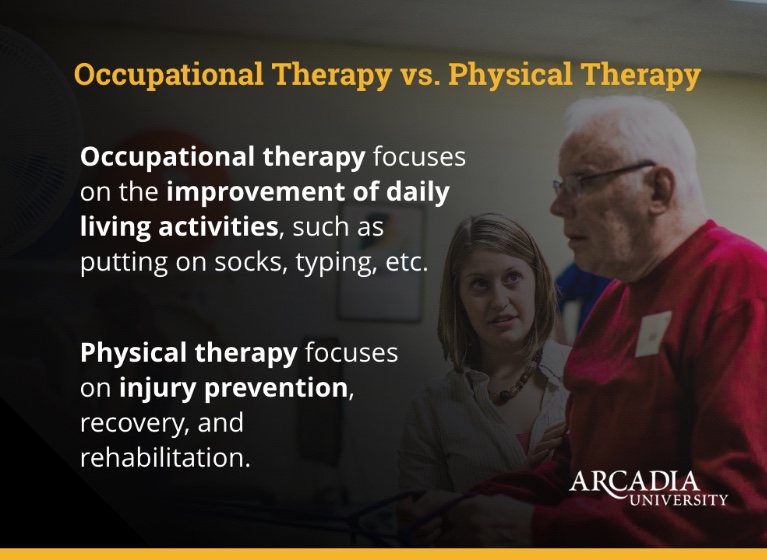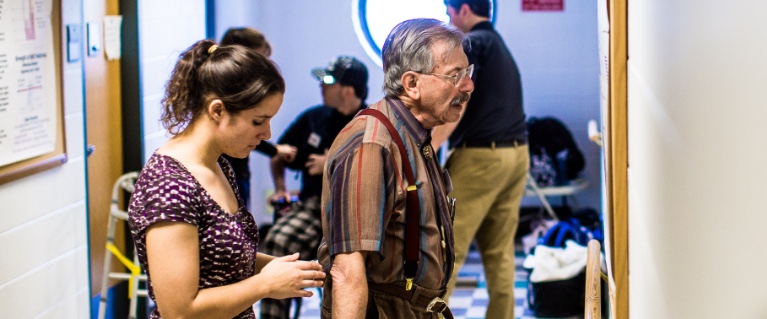Occupational Therapy vs. Physical Therapy
Occupational therapists and physical therapists dedicate their careers to rehabilitating, improving, and recovering their patients’ ability to move without pain or dysfunction.
If you want to pursue a career focused on helping people overcome movement challenges and improve their health and wellness, you may be interested in learning more about how to become an occupational therapist or physical therapist. Arcadia University’s College of Health Sciences offers both a Physical Therapy program, delivered in a hybrid format and on-campus, and a residential Pre-Occupational Therapy program for students interested in pursuing a career in these fields.
Click below to find out more information.
What Is the Difference Between Occupational Therapy and Physical Therapy?
Occupational therapy and physical therapy job duties overlap often. Both professions involve the care of patients who are suffering from an injury or illness that has negatively impacted their ability to move or perform certain activities.
Occupational therapy focuses on the improvement of daily living activities, such as putting on socks, typing, or using utensils. In contrast, a physical therapist focuses on injury prevention, recovery, and rehabilitation.

Jump to:
OT vs. PT
What Is an OT?
What Is a PT?
Becoming an OT
Becoming a PT
Career and Salary
What Does an Occupational Therapist Do?
According to the American Occupational Therapy Association (AOTA), occupational therapy is, “the only profession that helps people across the lifespan to do the things they want and need to do through the therapeutic use of daily activities (occupations).”
An occupational therapist’s job duties typically include the following:
- Review medical histories, ask questions, and observe patients performing activities or tasks
- Evaluate a patient’s specific condition and individual needs
- Develop a specific treatment plan for patients, identifying individual goals and the types of activities or exercises used to meet those goals
- Demonstrate exercises that can help relieve pain in people with chronic conditions
- Optimize a patient’s home or workplace based on the patient’s health needs and identify potential improvements
- Educate a patient’s family and employer about how to accommodate and care for the patient
When considering a career in occupational therapy vs. physical therapy, one aspect of occupational therapy that makes it unique is its guiding principle of comprehensive patient treatment.
With a focus on activities of daily living (ADL), occupational therapists examine, analyze, and evaluate every aspect of a patient’s lifestyle in an effort to rehabilitate or improve their overall wellness.
Jump to:
OT vs. PT
What Is an OT?
What Is a PT?
Becoming an OT
Becoming a PT
Career and Salary
What Does a Physical Therapist Do?
According to the American Physical Therapy Association (APTA), physical therapists are “movement experts who improve quality of life through prescribed exercise, hands-on care, and patient education.”
A physical therapist’s job duties typically include the following:
- Review patients’ medical history and any referrals or notes from doctors, surgeons, or other healthcare workers
- Diagnose patients’ functions and movements by observing them stand or walk and by evaluating their concerns, among other methods
- Develop individualized plans of care for patients, outlining the goals and expected outcomes
- Use exercises, stretching maneuvers, hands-on therapy, and equipment to ease pain, increase mobility, prevent further pain or injury, and facilitate health and wellness
- Evaluate and record a patient’s progress, modifying a plan of care and trying new treatments as needed
- Educate patients and their families about what to expect from the recovery process and how best to cope with challenges throughout the process
Unlike occupational therapists, who mainly focus on tasks such as bathing and getting dressed, physical therapists assist patients with specific body movements concerning strength, balance, and range of motion.
Their mechanical knowledge of anatomy enables them to home in on problem areas and draw specific plans to instigate recovery or rehabilitation.
Are you considering a career as a physical therapist? Arcadia University is now offering its No. 33-ranked DPT program in a hybrid format.
Request information today.
Jump to:
OT vs. PT
What Is an OT?
What Is a PT?
Becoming an OT
Becoming a PT
Career and Salary
How to Become an Occupational Therapist
Not everyone takes the same path to finding an occupational therapy career, and the requirements can change depending on the state in which you reside. Since 2007, all accredited programs have been offered at the master’s or doctoral levels.
The Pre-Occupational Therapy program at Arcadia University offers four competitive seats in the two-year, full-time Master of Science in Occupational Therapy (MSOT) program at Salus University to students who meet the criteria for admission.
Step 1 — Earn Your Bachelor’s Degree
Earning a relevant bachelor’s degree is typically the first step toward an occupational therapy career. Most four-year undergraduate degrees in biology, psychology, sociology, kinesiology, health science, or possibly liberal arts may satisfy the required courses and foundational knowledge necessary.
Step 2 — Higher Education and Field Experience
After you’ve earned a bachelor’s degree, the next step in your occupational therapy career path is to earn either a master’s in occupational therapy, which can take between two and three years, or a doctorate in occupational therapy, which takes about three years.
During your graduate studies, you’ll study subjects such as:
- Functional anatomy
- Neurobiology
- Kinesiology
- Foundations of occupational therapy
- Theoretical concepts and practice areas
- Occupation through the life span
- Therapeutic communication skills
When it comes to in-field or clinical experience, AOTA states that, “graduates of all programs must successfully demonstrate entry-level practice competency through 24 weeks of mentored practice experience.”
Step 3 — Pass the NBCOT Examination for Licensure
Once you have completed an accredited occupational therapy program, you are then qualified to sit for the national certification exam administered by the the National Board for Certification in Occupational Therapy (NBCOT). Licensing requirements vary by state, but all states require candidates to pass the NBCOT exam. Once you successfully pass the exam, you are qualified to practice.
Jump to:
OT vs. PT
What Is an OT?
What Is a PT?
Becoming an OT
Becoming a PT
Career and Salary
How to Become a Physical Therapist
The path to a physical therapy career is different than that of an occupational therapy career. There are no master’s degree options for aspiring physical therapists, only the Doctor of Physical Therapy (DPT) degree, which must be earned from a program accredited by the Commission on Accreditation in Physical Therapy Education (CAPTE).
Step 1 — Earn Your Bachelor’s Degree
According to APTA earning a bachelor’s degree is typically the first step toward a physical therapy career, as most accredited programs require it. Other DPT programs offer a “3+3” curricular format in which three years of undergraduate courses must be taken before the student can advance into a three-year professional DPT program.
Most four-year undergraduate degrees in biology, psychology, sociology, kinesiology, health science, or possibly liberal arts may satisfy the required courses and foundational knowledge necessary.
Step 2 — Earn Your Doctor of Physical Therapy Degree
After you’ve earned a bachelor’s degree or taken the relevant undergraduate courses, the next step to beginning a physical therapy career is to earn a DPT degree, which usually takes up to three years.
During your graduate program you’ll study subjects such as:
- Cellular histology
- Exercise physiology
- Biomechanics
- Endocrine and metabolic functions
- Musculoskeletal system
- Behavioral sciences
- Neuroscience
Most DPT programs have specific field experience prerequisites that you’ll need before you apply. Be sure to check all requirements when researching DPT schools. Having clinical experience field hours on your resume will be a great benefit as you search for DPT programs that are right for you.
Step 3 — Pass the NPTE Examination for Licensure
Once you have completed an accredited physical therapy program, you are then qualified to sit for the National Physical Therapy Examination (NPTE) administered by the Federation of State Boards of Physical Therapy (FSBPT). Licensing requirements vary by state, but all states require candidates to pass the NPTE. Once you successfully pass the exam, you are now qualified to practice.
If you’re ready to pursue your DPT, request information about Arcadia University’s No. 33-ranked, hybrid program today.1
Jump to:
OT vs. PT
What Is an OT?
What Is a PT?
Becoming an OT
Becoming a PT
Career and Salary

Occupational Therapy Careers and Salary
Occupational therapists have the option to treat patients as a generalist, working with a variety of patients in multiple settings, or acquire further education and training to focus on one avenue of occupational health.
Board Certifications and Specialty Certifications
Occupational therapists can become board certified in:
- Gerontology (BCG)
- Mental Health (BCMH)
- Pediatrics (BCP)
- Physical Rehabilitation (BCPR)
Occupational therapists can receive specialty certifications in:
- Driving and Community Mobility (SCDCM or SCDCM-A)
- Environmental Modification (SCEM or SCEM-A)
- Feeding, Eating, and Swallowing (SCFES or SCFES-A)
- Low Vision (SCLV or SCLV-A)
- School Systems (SCSS or SCSS-A)
Job Outlook and Pay
According to the Bureau of Labor Statistics (BLS), employment of occupational therapists is projected to grow 18 percent from 2019 to 2029, much faster than the average for all occupations.2
Holding roughly 133,000 jobs in 2018, the largest employers of occupational therapists were3:
- Hospitals; state, local, and private — 27%
- Offices of physical, occupational and speech therapists, and audiologists — 26%
- Elementary and secondary schools; state, local, and private— 11%
- Home healthcare services — 9%
- Nursing care facilities (skilled nursing facilities) — 9%
The median annual wage for occupational therapists was $84,270 in May 2018, and the highest paying industries they worked in were4:
- Nursing care facilities (skilled nursing facilities) — $90,570
- Home healthcare services — $87,570
- Offices of physical, occupational and speech therapists, and audiologists — $86,060
- Hospitals; state, local, and private — $84,550
- Elementary and secondary schools; state, local, and private — $73,980

Physical Therapy Careers and Salary
Similar to occupational therapists, physical therapists have the option to remain generalist practitioners or become board certified in up to nine specialty areas.
Physical Therapy Specialty Areas
Specializations are a way for physical therapists to further their career and become experts in a given field or practice. Through the American Board of Physical Therapy Specialties (ABPTS), physical therapists can specialize in:
- Cardiovascular and Pulmonary
- Clinical Electrophysiology
- Geriatrics
- Neurology
- Orthopedics
- Pediatrics
- Sports
- Women’s Health
- Oncology
To be qualified to pursue a physical therapy specialization, you must have a minimum of 2,000 hours of clinical practice in the specialty area, 25 percent of which must have occurred within the last three years.
Job Outlook and Pay
According to the BLS, employment of physical therapists is projected to grow 22 percent from 2018 to 2028, considerably faster than the average for all other jobs.5
Holding about 247,700 jobs in 2018, the largest employers of physical therapists were6:
- Offices of physical, occupational and speech therapists, and audiologists — 33%
- Hospitals; state, local, and private — 26%
- Home healthcare services — 11%
- Nursing and residential facilities — 7%
- Self-employed workers — 5%
The median annual wage for physical therapists was $87,930 in May 2018, and the highest paying industries they worked in were7:
- Nursing and residential care facilities — $94,010
- Home healthcare services — $92,660
- Hospitals; state, local, and private — $89,950
- Offices of physical, occupational and speech therapists, and audiologists — $83,280
Start Your Journey with Arcadia’s Hybrid DPT
Arcadia University’s College of Health Sciences is now offering its No. 33-ranked Doctor of Physical Therapy (DPT) program in a hybrid format.8
As an Arcadia hybrid DPT student, you’ll be able to:
- Complete the program in as few as 26 months
- Gain hands-on skills during 32 weeks of in-person trainings
- Collaborate with award-winning faculty who are at the forefront of DPT research
- Learn from an innovative, patient-centered curriculum driven by the latest DPT science
Fully accredited by the Commission on Accreditation in Physical Therapy Education (CAPTE), Arcadia’s hybrid DPT program enables students to earn a DPT from a top-35 ranked school without relocating.
Are you ready to pursue a rewarding career as a licensed physical therapist?
Request information about Arcadia’s Hybrid DPT Program to take the first step.
1 U.S. World News & Report, Best Physical Therapy Schools. Accessed in August 2024. arrow_upwardReturn to footnote reference
2 Bureau of Labor Statistics, Occupational Therapists, (Accessed August 2024) arrow_upwardReturn to footnote reference
3 Bureau of Labor Statistics, Occupational Therapists, (Accessed August 2024) arrow_upwardReturn to footnote reference
4 Bureau of Labor Statistics, Occupational Therapists, (Accessed August 2024) arrow_upwardReturn to footnote reference
5 Bureau of Labor Statistics, Physical Therapists, (Accessed August 2024) arrow_upwardReturn to footnote reference
6 Bureau of Labor Statistics, Physical Therapists, (Accessed August 2024) arrow_upwardReturn to footnote reference
7 Bureau of Labor Statistics, Physical Therapists, (Accessed August 2024) arrow_upwardReturn to footnote reference
8 U.S. World News & Report, Best Physical Therapy Schools. Accessed in August 2024. arrow_upwardReturn to footnote reference

